The world of sushi is vast! It ranges from the lowest chain salmon-only shop in America to the most exclusive, high-quality nigiri sushi-ya in Japan. Although I have had sushi previously in other sushi shops in London, nothing prepared me for the difference in taste and quality when I first tried sushi in Japan almost six years ago. Since that first time when I tried some of those mouthwatering, hand-pressed nigiri’s, I have always wanted to see what the best, most authentic Japanese sushi in the world tasted like. After watching Jiro Dreams of Sushi, a film about one of the best (if not the best) sushi chef’s in the world, I knew that I wanted to try Jiro’s sushi and see what it tasted like. Jiro’s is still one of the hardest places to get a reservation for! However, they do have two branches (one in Ginza and one in Roppongi) and the sister branch is easier to get a reservation for. Interestingly enough, since the release of the film and the growing conversation on the influence of the West in respecting sushi culture, many Japanese people now prefer sushi from the sushi chef Saito and see him as the best sushi chef in the world as opposed to Jiro Ono, who had the film made about him.
However, as the original (and world-famous) sushi-ya, the Jiro restaurant is still almost impossible to get a counter seat at. The chefs at the sushi-ya lead a family business, and the Roppongi branch is headlined by Jiro Ono’s son Takashi-san, who is a wonderful sushi chef in his own right. He has carried on his father’s style in making sushi and uses traditional techniques and tools for its creation, as well as influencing the sushi he serves with his own style. He was mentioned in the film as being the ‘independent’ son who grew up learning side-by-side with his father at the counter. He was the only one out of the two sons who went on to set up his own sushi-ya. Although he did not stay on at the original branch, his sushi does represent the same style as his father’s. The customary Jiro staples: classic steamed eel with a soft teriyaki glaze, as well as finishing the course with the cake-like tamago (sweet egg custard). These are welcome additions to those worried that they won’t be able to get a taste of the world’s best sushi at the Roppongi branch.
On to the actual evening when we went to Jiro Roppongi last year. Luckily because we came early we were the first customers at the restaurant and so we did wait a little while outside just to make sure we weren’t late! The sushi-ya is located in the Roppongi shopping complex, but it sits tucked well away from the hustle and bustle of the shops over the bridge on the quieter side of the shopping centre. There are a few good quality restaurants very close by, and Jiro Roppongi is the furthest away from the shopping centre, right at the end of a long walkway. However, the inside decor is exactly like that of any of the sushi restaurants I have been to in Japan- the inside is mostly wood, with a long counter and multiple seats, as well as a couple of tables on the side for larger tables.

The original omakase course menu consists of all the best sushi pieces at sushi-ya Jiro. This begins with lighter, more citrusy fish and shellfish, then moving on to slightly deeper, more complex flavours and finishing with oily fish like tuna, and others like eel and the tamago sushi round off the end of the meal.
Introductory Dishes (side dishes and sashimi):

Broccoli Appetiser
The above course consisted of a light appetiser before we started the fish courses. It featured some seasoned and pickled broccoli shoots that had been marinated in a light, soy flavoured sauce. Delicious and very cold, this was a welcome pick me up after the cold outside air!

Hirame (flounder) and Akagai (red clam)
Beginning with the freshest sashimi of slightly more textured shellfish and fish pieces, the akagai (red clam) on the right and flounder were both slightly wet and crisp. As shellfish is more commonly found in omakase courses in the winter, the akagai is one of the more popular choices!

Awabi (abalone)
The next piece of shellfish is considered to be one of the most expensive ingredients in an omakase course. Abalone, a large, oval-shaped, muscular sea delicacy has a distinctive light marine flavour, which brings the sea to mind in its delicate flesh. Abalone is notorious for being very hard to prepare well- many restaurants do not know how to cook it so that the prized ingredient doesn’t come out tough and inedible. The abalone at Jiro’s was perfectly firm and moist- the best abalone I have tried to date!

Bonito (skipjack tuna)
Bonito in Japan has many uses as a dried fish ingredient- the shavings from katsuo are the key ingredient for dashi stocks and soups. However, bonito (skipjack tuna) is also a really great fish at sushi restaurants- it has a great citrusy flavour to the flesh, and as sashimi, it keeps its bright red colour to liven up any plate. Bonito at Jiro’s are prepared differently to other sushi-ya’s I have seen- the fish is smoked over straw for it to get cooked lightly around the surface, creating a contrast between the smoky, crisp outside and the melting, zingy flesh inside. This is always one of my favourite parts of the omakase courses!
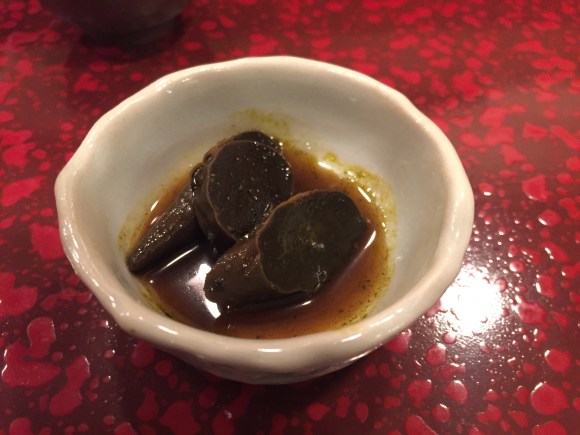
Awabi Kimo (abalone liver)
This is a prized part of one of the shellfish I had already described- the abalone. Served separately, the dark, strange-looking abalone liver is called the foie gras of the sea for its similarly smooth, creamy texture as well as its strong flavour. This is not a dish for everyone, as the flavour does seem very odd at first, but I have learnt to enjoy it more and more each time I taste it. At Jiro’s, the abalone liver is served with a light sweet broth which brings out its sweetness.
All the time during our courses, the lady who first took our coats serves out the drinks and keeps watch for any spills on the long wooden counter. With an eagle eye, she makes sure that no one is left without a drink or a clean surface, and all the dishes are timed perfectly so all the customers who were with us at the counter were served at exactly the same time.
Sushi Course (the main part of the omakase):

Hirame (flounder)
Sometimes sushi chef’s will serve you certain fish, like those which are best in season twice during one course- once as sashimi, and once as sushi, usually by cutting away from two different parts of the fish for a slight deviation in texture and flavour. For Jiro’s, this fish was flounder, and as it was January, this big, flat fish with white flesh is highly prized during this time. All the sushi at Jiro’s is served without extra wasabi or soy sauce on the side for customers. The sushi is lightly brushed with soy sauce before it is given to you, so there is never a need for extra seasoning. The flounder sushi was incredibly crisp and moist at the same time, with the first taste of Jiro’s rice bringing in a heady umami and rice vinegar smoothness to the fish and rice mix.

Ika (squid)
Ika, or squid, is a popular choice for sushi seafood during the winter for its brilliant white flesh and its unparalleled crunchy exterior/smooth interior contrast. Squid does come in multiple varieties, with the smooth style presented here offering no alterations from the base way of serving this slippery and unctuous mouthful. Again, this was served exactly how it looked with the soy sauce painted on, with no alternate seasonings.

Sayori (Needlefish)
This was an unusual addition to an omakase course, as I had never tried this fish previously. Described by the sushi chef as the ‘needlefish’, the light and soft flavour of the fish was very surprising! I was expecting the needlefish to be tougher in texture like the flounder, but I was pleasantly surprised to find that the flesh yielded easily to the tongue, with the deep grooves of the muscles allowing for even penetration of the soy sauce into the layers of the fish.
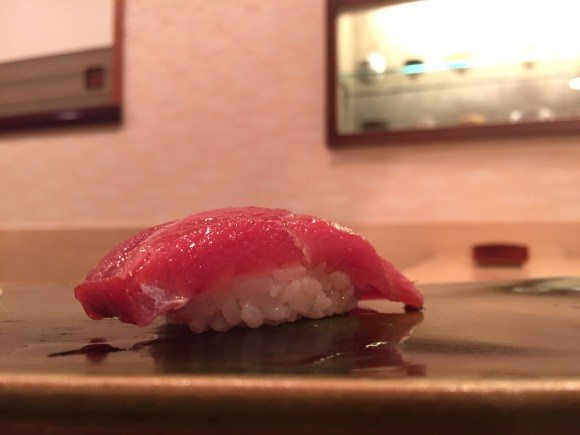
Akami (lean tuna)
The sushi ‘golden trio’ of fish is only known as the tri-tuna presentation. Every omakase menu usually consists of all three of the tuna cuts. The scale of how fatty the tuna is the reason for its different names, ranging from akami (least fatty) to chutoro and the fattiest o-toro respectively. This piece above was the akami, or the leanest cut. I remembered that in the film, Jiro’s belief was that the best cut of tuna was the akami, and that it was only through tasting the akami that you understood what real tuna flavour was. The akami was surprisingly soft and delicate, with a light flavour of tuna that harmonised perfectly with the touch of soy sauce. This was by far the best akami I had ever tasted. I am not sure whether all the cuts of tuna are aged at Jiro’s before being served, but I am pretty sure even the akami had been matured over a couple of days as the flavour was more pronounced here than at some of the other sushi-ya’s I have eaten at.

Chutoro (mid-fatty tuna)
The chutoro is usually the most popular tuna part for the local Japanese, although tourists usually prefer o-toro for its fattier and more luxuriant flavour. As the midway in between the leanest and the fattiest, it achieves a nice balance between the two, with one side of the fish usually being fattier than the other, letting the flavour spread from one side of the mouth to the other (in the picture above, the left-hand side is visibly more marbled, bringing that side of the nigiri closer to the otoro flavour). I personally love the chutoro pieces, and I think they are by far the best overall in any sushi course as the flavour of the fish is unsurmountable. All the tuna received for nigiri at Jiro’s is marinated in rice wine vinegar for a couple of days before it is served to its customers. I think a lot of people coming from abroad that although some ingredients in sushi are meant to be eaten raw and as fresh as possible, other cuts like tuna and bonito are cooked part way or marinated to enhance certain characteristics of the flavour. This piece was the perfect example of a peak chutoro piece, with the biggest surprise for me coming from the fact that the sushi did not feel heavy or greasy, even with the considerable marbling.

O-toro (fatty tuna)
The most prized part of the tuna is believed to be the o-toro, which comes from the harakami (underbelly) of the tuna. The o-toro at Jiro was again, very light and tasted fresh even with the heavy marbling of the flesh. Jiro Ono describes his course sequence to be aligned to a cadenza in music- you serve lighter fish first, then gradually lean towards heavy, rich-tasting fish and seafood, finishing with sweeter flavours of eel, egg and some alternatives like the hosomaki. The o-toro piece is supposed to be the peaking in the course, and it is up to this piece that most chefs build up to. After this course, the introduction of hojicha tea’s brings a gradual decline of the course, so that there is a visible distinction in the stages of your meal. This is strange, as you would expect the sushi course to not feel different (essentially, you are still eating pieces of seafood with rice), but the tone of the meal decidedly changes, and the o-toro does feel almost like the main course.
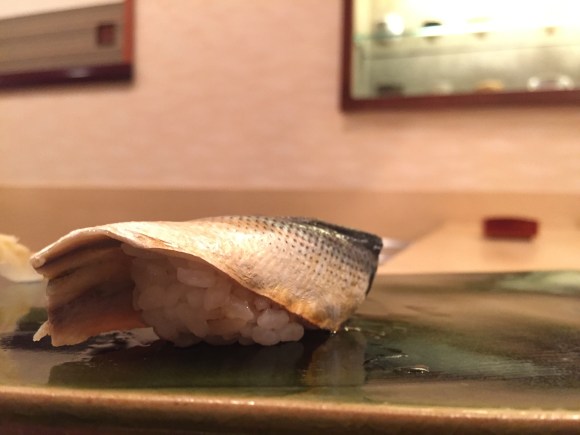
Kohada (gizzard shad)
With the impact of the fatty tuna still on our tongues, this heavily flavoured, vinegared kohada (Gizzard Shad) balanced well with the fatty tuna previously, acting like a palette cleanser. The taste was sharp and refreshing, making it perfect for the post-tuna flavour. This fish has a brilliant shiny black and white linear scale pattern, and it is one of the most visually appealing pieces of fish, along with the likes of mackerel or red sea bream, which also have brilliantly coloured surfaces that add some colour to the sushi. I personally prefer these types of fish for flavour, as I think the soft flesh of these fish pair better with rice for nigiri, as opposed the crunchier clam, or other shellfish.

Ikura (salmon roe)
Ikura, or salmon roe, is almost always a staple in high-end sushi-ya’s, as the flavour quality depends on a fresh and expensive product, showcasing the best that the chef has to offer. It is also very popular in winter. This addition to the selection at Jiro Roppongi shows that the chef values salmon roe only when it is in season. He said that doesn’t serve this to customers over the summer when salmon roe is not in season. Sometimes you may order a favourite fish at a sushi restaurant and find that they choose not to stock it, as they believe that seasonal produce is best and they do not provide all the fish year round. Although this is slightly disappointing for those interested in trying all types of fish, or those who have only a few favourites and do not rely on seasonal food at home, it is the best way to make sure that certain popular items don’t become endangered or lose their quality through overfishing. The ikura at the restaurant was encased in a thin strip of crisp nori that had been toasted over an open flame, which complemented the little cold eggs perfectly.

Aji (horse mackerel)
Aji, or horse mackerel, was served next. This fish also comes under the same category for me as the mackerel and gizzard shad- it has a sharp, fresh flavour that is lightly accented by the brushing of soy sauce. This is one of my favourites, and it contrasts well with the sushi rice. It has the sweetest flavour out of all of the mackerel’s served, and it naturally progressed the course from the vinegared fish part of the course to the sweeter seafood part.

Ebi (prawn)
Ebi, or prawn is one of the most impressive pieces of sushi during the course at Jiro Roppongi. The prawn is served whole, without the head, and lightly boiled and kept warm. This gave it a nice texture that was only brought out more by the sushi rice. Most sushi restaurants don’t serve boiled shrimp for sushi anymore- it has become a trademark of chain sushi shops, as the boiled prawn is easier to store than the raw prawns. However, this preparation and the attention given to the gentle, and yet firm texture of the prawn made the sushi truly exceptional! The method of cutting in it two also created two evenly sized pieces. Some high-end sushi restaurants prefer to impress the guests with the size of the prawn by presenting it whole, but this does make it difficult to eat. Smaller mouths may have trouble with such a mouthful, so I am grateful that the sushi chef Takashi-san made them a little smaller.

Akagai (giant clam)
The sweet taste of raw shellfish like akagai is perfect for a light ending to the meal. Although this was not the last piece of sushi, it does end the sequence of the fresh fish, with a slightly crunchier texture than that of scallops or raw prawn. It is a very expensive shellfish and rarely seen outside of the season, so I am very lucky to have tried this when we were at the sushi-ya! It has a great briny texture that is both soft and has a bit of a bite to it.
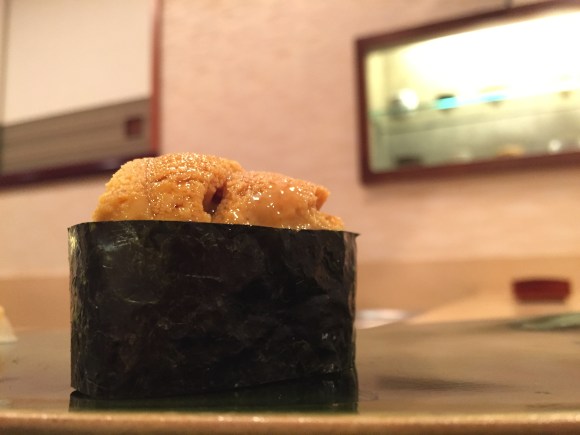
Uni (sea urchin)
Sea urchin may be a lot to stomach for some, but the creamy texture and the melt-in-the-mouth feeling is something that many people end up loving at high-end sushi restaurants. Bought in in the famous little wooden boxes, the golden gleam from the treasure chests of uni is something that adds a royal colour to the spread of pink and red that was brought in with the other fish like tuna and mackerel. After so many trips to different sushi places, I still have not found a taste for it, but it doesn’t stop me from trying! The uni at Jiro Roppongi was incredibly smooth and creamy, but still not 100% to my taste. I think that this and shirako sushi will never be exactly to my taste…
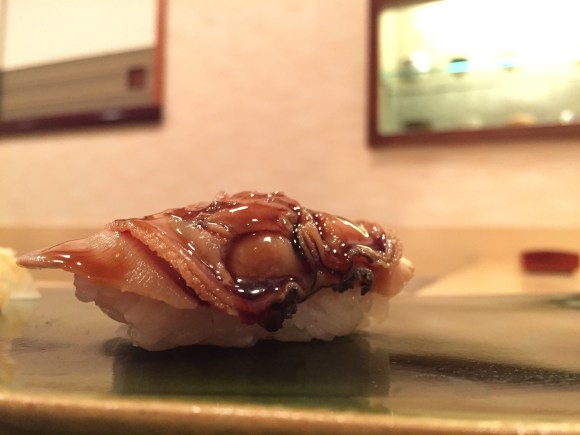
Hamaguri (arkshell)
This arkshell, a type of shellfish, was an unexpected surprise during the dinner. The sauce that they use to coat the unagi later on in the course is also used on the hamaguri. It gives the crunchy arkshell both the taste of the sea from the flesh and a taste of the sweet marinade of soy sauce and sugar. I am not sure about this combination as the arkshell does taste fresh on its own, so slathering it in such an unctuous sauce may be a little too much. The combination was very good and it made me look forward to trying the eel, which is always a difficult piece of sushi to pull off on account of all the small bones in the eel that sometimes take away from the pillowy texture of the eel itself.

Shimesaba (marinated mackerel)
The most amazing part of going to a great sushi-ya like Jiro Roppongi is that you get to request any of the sushi or sashimi that you have already had, as well as anything that you might personally like that wasn’t presented during the omakase tasting course. For me, this was the shimesaba, or vinegared mackerel. Although I had already had two different varieties of vinegared fish during the course, I always try to taste the shimesaba because every sushi restaurant prepares it differently, varying the time in and strength of the vinegar, making for a slightly different piece at each new place. Here the shimesaba was not too vinegary or salty- it had been prepared with the utmost care for keeping the flavour of the fish vibrant, as opposed to overpowering it.

Hotate (scallops)
Scallops are usually a firm favourite at any sushi-ya, as the sweet, meaty flesh of the scallops explodes in the mouth with the rice, making it one of the more exciting and yet very lightly flavoured sushi pieces. However, scallops are usually best in the summer, so we received the smaller scallops instead of the larger ones. These had more yellow flesh, which was also very sweet and the scallops and small mounds of rice were encased in the same toasted nori sheet as before, making for a nice contrast between the rice, scallop and nori.

Unagi (eel)
The eel is almost always the second to last piece of sushi, as the sweet taste of the sauce and the gentle soft flesh makes it a perfect sweet ending to the course. It is the least briny out of the fish served as the eels caught are usually sweetwater. This piece in particular was incredibly soft with almost no bones, making it the best unagi I have ever had! The sauce was not overly sweet, and it actually had a slightly smoky flavour to it, accenting the eel sushi beautifully. Normally this isn’t a piece I enjoy that much as I find the sauce to be too thick and the eel holds together too much, but the chef made sure that the eel was just freshly cooked, making it fall apart in the mouth.

Tamago (egg custard)
This last piece of sushi (if you can call it that without the rice) is the traditional egg custard, which is meant to be a semi-sweet end to the whole omakase course. The tamago sushi at Jiro Roppongi keeps to the style of the original style served at his father’s. Both sides of the egg custard are lightly boiled, resembling another famous Japanese classic- castella. The pillowy, soft and moist texture of the tamago is perfect to end such a wonderful course meal!

The end of the meal was perfect, and overall this has got to be one of the best sushi experiences I have ever had. I love how quiet the restaurant was during our meal with only a couple of other guests, which really let us interact with the chef and see his work. Apart from the actual sushi, seeing the chef cut the fish and lightly place it together with the rice is one of my favourite parts of the meal. Although the chef Takashi-san was quiet and focused on the sushi during the course, he relaxed and was very happy to talk a bit in English with the guests after the meal! I was very surprised as he is the only head sushi chef so far that has been happy to talk in English and engage with the guests after the meal. We left incredibly happy with the meal, and I would love to go back there again to see more mastery from Takashi-san.
If you have been to Jiro Roppongi, I would love to hear you experiences from your evening!

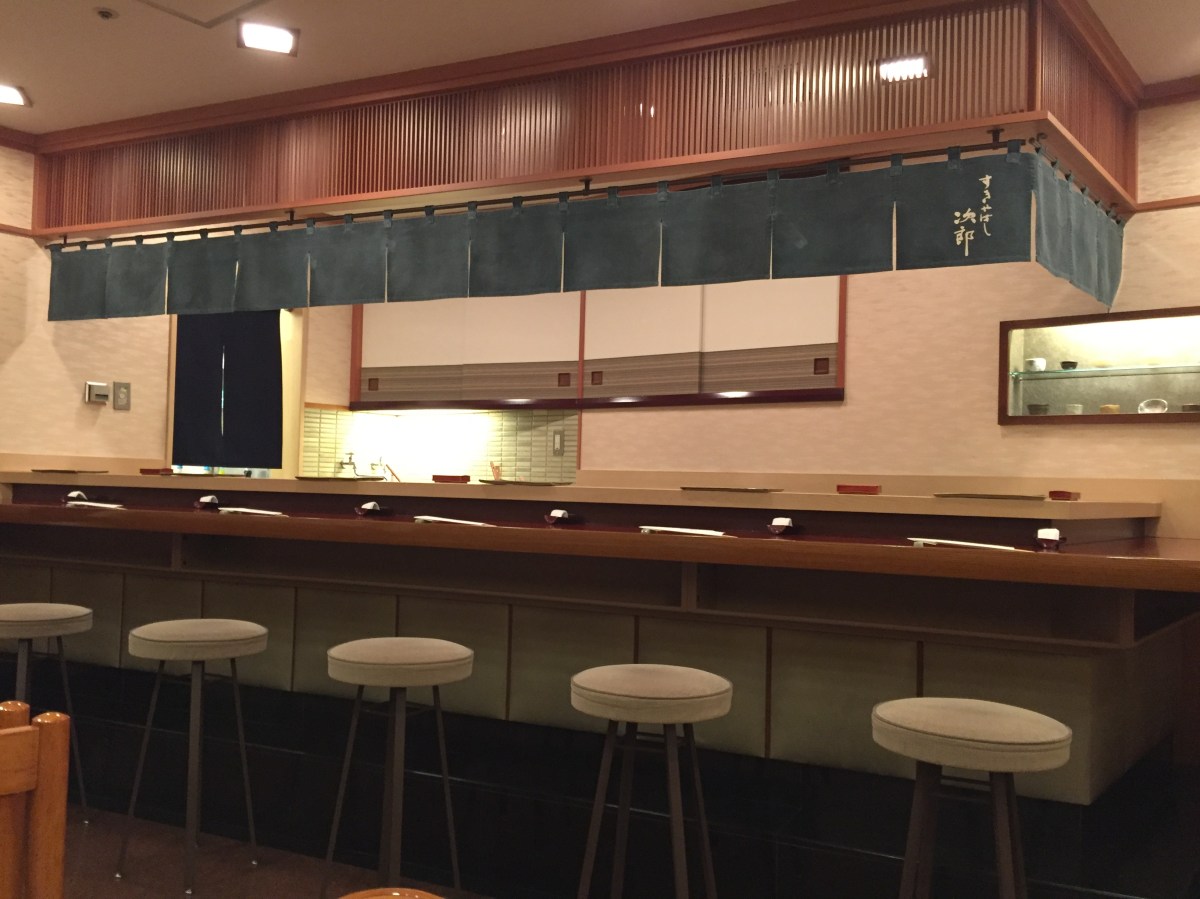
2 replies on “Sushi Jiro Roppongi”
Loved this awesome dishes…feeling uncontrollable after seeing it 🙂
[…] Sushi Jiro Roppongi Review […]